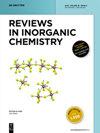Comprehensive reviews on the potential applications of inorganic metal sulfide nanostructures in biological, environmental, healthcare, and energy generation and storage
IF 3.1
3区 化学
Q1 CHEMISTRY, INORGANIC & NUCLEAR
引用次数: 0
Abstract
The versatile nature of metal sulfide nanostructures has led to their meteoric rise in popularity. The compositions, morphologies, and sizes of these nanostructures may be tuned, giving them distinct features. Here we look at the many uses of metal sulfide nanostructures, with an emphasis on their possible benefits in the fields of biology, ecology, and energy storage. Because of their remarkable optical characteristics and high degree of biocompatibility, metal sulfide nanostructures have great potential in the biological fields of bioimaging, medication administration, and photothermal treatment. Additionally, because of their large surface area and adsorption capability, these nanostructures show outstanding performance in environmental remediation, which includes pollutant removal and wastewater treatment. Because of their great conductivity and electrochemical activity, metal sulfide nanostructures are also in great demand for energy storage applications such supercapacitors, hydrogen storage, and lithium-ion batteries. This review provides a comprehensive analysis of recent progress in synthesizing various metal sulfides with transition metal elements. Effective physiochemical and biological approaches are employed in their production to control the structures, dimensions, and compositions of these sulfides.全面评述无机金属硫化物纳米结构在生物、环境、医疗保健以及能源生成和存储方面的潜在应用
金属硫化物纳米结构的多功能性使其迅速蹿红。这些纳米结构的成分、形态和尺寸都可以调整,从而使它们具有与众不同的特征。在这里,我们将探讨金属硫化物纳米结构的多种用途,重点是它们在生物学、生态学和能量存储领域可能带来的益处。由于具有显著的光学特性和高度的生物相容性,金属硫化物纳米结构在生物成像、给药和光热治疗等生物领域具有巨大潜力。此外,由于这些纳米结构具有较大的表面积和吸附能力,因此在环境修复(包括污染物去除和废水处理)方面表现出色。由于具有很强的导电性和电化学活性,金属硫化物纳米结构在超级电容器、储氢和锂离子电池等储能应用中也有很大的需求。本综述全面分析了最近在合成含有过渡金属元素的各种金属硫化物方面取得的进展。在生产过程中采用了有效的物理化学和生物方法来控制这些硫化物的结构、尺寸和成分。
本文章由计算机程序翻译,如有差异,请以英文原文为准。
求助全文
约1分钟内获得全文
求助全文
来源期刊

Reviews in Inorganic Chemistry
化学-分析化学
CiteScore
7.30
自引率
4.90%
发文量
20
审稿时长
1 months
期刊介绍:
Reviews in Inorganic Chemistry (REVIC) is a quarterly, peer-reviewed journal that focuses on developments in inorganic chemistry. Technical reviews offer detailed synthesis protocols, reviews of methodology and descriptions of apparatus. Topics are treated from a synthetic, theoretical, or analytical perspective. The editors and the publisher are committed to high quality standards and rapid handling of the review and publication process. The journal publishes all aspects of solid-state, molecular and surface chemistry. Topics may be treated from a synthetic, theoretical, or analytical perspective. The editors and the publisher are commited to high quality standards and rapid handling of the review and publication process.
Topics:
-Main group chemistry-
Transition metal chemistry-
Coordination chemistry-
Organometallic chemistry-
Catalysis-
Bioinorganic chemistry-
Supramolecular chemistry-
Ionic liquids
 求助内容:
求助内容: 应助结果提醒方式:
应助结果提醒方式:


